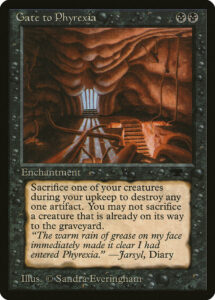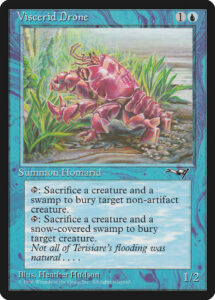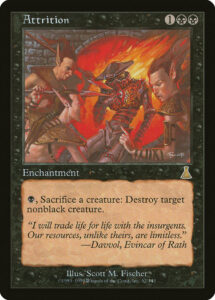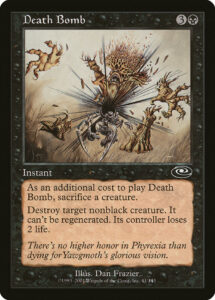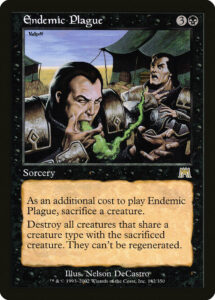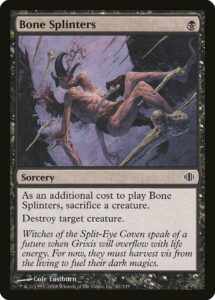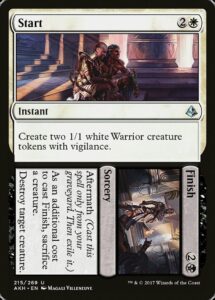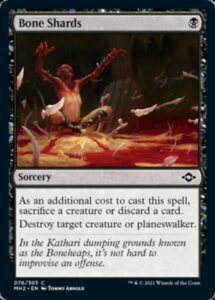One of the best black commons in Modern Horizons 2 is Bone Shards. Yet despite its power, I’ve still heard players undervaluing it, not realizing its low (and often beneficial) cost. If you’ve been playing for a while, it’s obvious why Bone Shards looks bad: we’ve seen cards like this for years and they generally performed poorly. Its name and effect are so similar to Splinters">Bone Splinters that it’s easy to overlook just how powerful Bone Shards is.
So today, let’s review the history of this entire mechanic to appreciate how this effect has evolved over time and how recent innovations have made for much more interesting twists on Death Bomb.
Losing Value to Cheat
In the beginning, Gate to Phyrexia and Phyrexian Tribute introduced the concept of incurring card disadvantage when you desperately need to remove something. In this case, black was given the color pie-breaking ability to destroy artifacts.
Gate to Phyrexia is one of the best early instances in the color pie debate. Should colors have zero access to out-of-pie abilities? Or should they get awful versions to demonstrate their deficiency? It’s also a reminder that black was perhaps the most hamstrung color in early Magic, since it wasn’t allowed to interact with artifacts, enchantments, or black creatures—a tension that lasted through a majority of Magic’s history, with the nonblack restriction going away in the past decade and the enchantment restriction only being loosened in the past two years.
Creatures exploiting creatures
Welcome to Alliances, land of colors having random alliances with each other. Despite its low rate and fairly murky story, Viscerid Drone provided one of the first examples of repeatable, unconditional creature removal (though at much greater cost than Royal Assassin). While it’s odd seeing a blue creature with a black textbox, this is both emblematic of how wacky early Magic design could be, as well as an instance of how one can play in multicolor spaces without making strictly multicolor cards.
Flash forward a couple years and Stronghold Assassin comes out, becoming a much more powerful version of repeatable Bone Splinters. Though it notably is card advantage neutral, since it can always sacrifice itself—making it a different from most other cards in this vein. Deathmark Prelate followed this design vein a few years later and probably hits the sweet spot on balance for recursive removal in the early 2000s, since it can’t sacrifice itself, has to function at sorcery speed, and requires serious tribal support to function.
All were good lessons likely drawn from Attrition, the dominant card we’ll discuss next. But we still today see creatures recursively sacrificing each other for removal, be they Skirsdag Flayer, Grimgrin, Corpse-Born, Eater of Hope, Sanguine Praetor,or General Kudro of Drannith (as well as those just doing it once, like Silumgar Butcher and Loathsome Curator).
The only winning move is not to play (nonblack creatures)
We know that the story is going to feature mediocre spells soon enough, but Attrition is a serious powerhouse. Sure, it’s card disadvantage, but trading 4 for 3 is much less painful than trading 2 for 1—and you still have an Attrition on the battlefield ready to be used again.
There’s some really smart design here, since there are several ways to cheat on this bad exchange: you can generate tokens, bring your creatures back from the graveyard, or simply trade your worst creatures for your opponent’s best. The design’s problem is the dearth of counterplay—unless you have black creatures, enchantment removal, or can play more creatures than your opponent, the right countermove is to stop playing creatures and let the game grind to a halt.
That was a common problematic play pattern in early Magic, and Attrition does a good job of reminding us how dangerous repeatable effects can be, even inherently weak ones. Almost twenty years later, Eliminate the Competition would do the exact same design without the recursive issues that made Attrition both so powerful and so problematic.
Death on command
Finally, we have this effect on a spell and it sets the stage for decades of disappointment. In the era of Terror, Dark Banishing, and generally weak creatures, Death Bomb would have drastically underperformed. But in Invasion block in particular, where half of all creatures were mini-Mulldrifters, spending two resources to deny your opponent one was an awful deal. It was a weak spell in a format especially hostile format to it.
As a design, Death Bomb is perfectly good. It’s a fairly clean effect with a bonus. It provides a little puzzle, since you can mitigate the card disadvantage by sacrificing a creature in response to removal or damage being on the stack (a rule that wouldn’t go away for eight years). A decade later, Launch Party would revisit the design with cleaner templating more egalitarian in its targeting. It still wasn’t particularly strong, but Limited is better when some removal spells aren’t top shelf quality (and Death Bomb effects wouldn’t be that good for a while).
A specific sort of sacrifice
Endemic Plague has an incredibly high ceiling—a four mana Plague Wind. But its floor is incredibly low—sacrifice a creature to blow up your own board and leave your opponents’ creatures unscathed. It had a little bonus play to it, since you could employ blue’s Mistform creatures to control the destruction. Five years later, it could employ Lorwyn’s changelings to blow up everything other than Nameless Race. But we haven’t seen much following directly in Endemic Plague‘s path.
A great design—simple, clean, and weak
Bone Splinters has been around and mediocre for a long time. (In two years, its 2008 appearance will be closer to Magic’s birth than the present day.) At the time, it synergized with Grixis’ Unearth mechanic and all the token support that made Jund Devour function. Those synergies and its outstanding mana cost still weren’t enough to offset the extreme disadvantage of spending two cards to eliminate one. That’s not to say that it’s a bad design—it’s a beautifully simple card—but by losing Death Bomb‘s instant speed, a substantial part of the interesting puzzle is lost. Bone Splinters is defined by planning around card disadvantage or begrudgingly accepting it out of necessity, not finding the right timing to outright avoid it.
Later on, we would get Flesh Allergy and Severed Strands (alongside many Bone Splinters reprints) that turned the 1 for 2 into a 1.1 for 2—fine little innovations, but ones that were always doomed to be removal reserved for the most desperate decks and situations. Mutual Destruction would flirt with turning Bone Splinters back into Death Bomb but was so difficult to set up that it’s essentially the same card but with trinket text, making it less elegant.
Circumventing the downside
Start to Finish is the beginning of the modern era of Bone Splinters-style cards. By combining a mediocre Bone Splinters with a mediocre Raise the Alarm, the puzzle solves itself—it’s now a six mana creature removal spell you can pay in installments that leaves behind a bit of value. This isn’t a premium removal spell and it makes for a less interesting design since it answers the very question it asks, but it started a ball rolling that went in good directions.
Final Payment changed the formula by diversifying the costs. Instead of having to offer up the same resource in exchange for your opponent’s creature, you could offer up an enchantment. Or for the hefty cost of five life, you could circumvent card disadvantage entirely. The numbers on Final Payment are great—a two mana removal spell is potent but not broken in an era of powerful two and three drop creatures. Five life is a hardly trivial sum, so rather than constantly pay it no matter the situation, the card encourages you to either time it in response to an opponent’s removal spell or in conjunction with an Afterlife. But by not mandating that you always sacrifice a creature, it becomes far more flexible and powerful.
Spark Harvest continued this trend by offering an even easier alternate cost: mana. While neither Bone Splinters nor Weed Strangle is impressive, the choice of either is more than the sum of its parts. Spark Harvest is also one of the first commons to reference planeswalkers. This made perfect sense in War of the Spark, the planeswalker set, but it also heralded an overall change to Magic allowing most interaction to hit planeswalkers, regardless of rarity.
Nearly thirty years of have brought us to Bone Shards. Unlike Final Payment and Spark Harvest, it forces you to engage with card disadvantage. Unlike Final Payment and Death Bomb, it’s sorcery speed, so you can’t use your opponent’s (non-aura) removal to mitigate that loss of value. For those reasons, it’s easy to see Bone Shards as a slightly improved but still weak twist on Bone Splinters (or not even notice that it’s a different card from its synonymous ancestor).
But Bone Shards is outstanding, and it accomplishes that in multiple ways. There’s the obvious MH2 method of turning downside into upside via Madness. There are the ancillary ways of generating value, like discarding to enable Delirium, Escape, or Threshold. But there’s also the subtler fact that discarding a card is a much easier cost to pay than sacrificing a creature—creatures require an investment to put onto the battlefield, but cards freely flow into your hand each turn. Sure, it’s card disadvantage to just discard without value, but Bone Shards provides an excellent example of how not all card disadvantage is equal. It’s a lot less painful to throw away a card you didn’t pay for than one you did.
For all we know, the next decade could see a burst of powerful variants on this theme, or it could defined by easier to use removal with Bone Splinters and Launch Party warming the bench. Magic is a hungry monster and I’m happy to see the pendulum swing, regardless of what direction it takes.
And, as always, thanks for reading.
Zachary Barash is a New York City-based game designer and the commissioner of Team Draft League. He designs for Kingdom Death: Monster, has a Game Design MFA from the NYU Game Center, and does freelance game design. When the stars align, he streams Magic (but the stars align way less often than he’d like).

